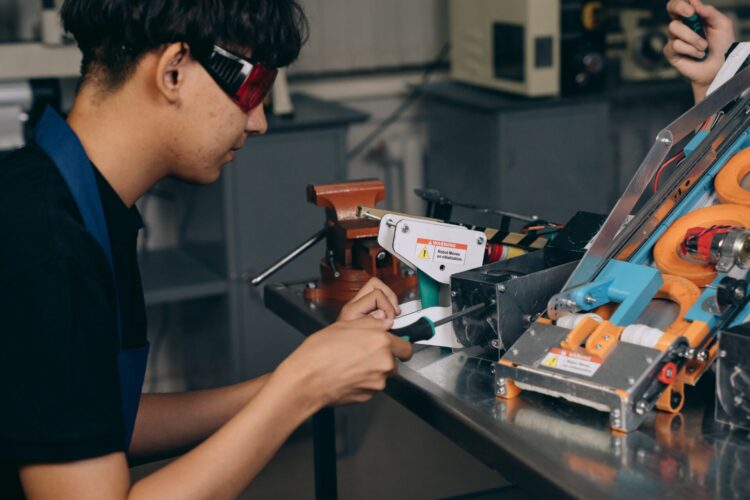Introduction:
In today’s rapidly evolving technological landscape, two terms that have gained significant prominence are Artificial Intelligence (AI) and Machine Learning (ML). These concepts, often used interchangeably, are the driving forces behind numerous innovations that have transformed industries across the globe. In this article, we will delve into the core aspects of AI and ML, highlight their differences, explore their relationship, and address the question of which is better suited for various applications.
What is Artificial Intelligence and Machine Learning?
Artificial Intelligence, simply put, refers to the simulation of human intelligence in machines. It involves creating algorithms that enable computers to mimic human-like cognitive functions such as reasoning, problem-solving, and decision-making. On the other hand, Machine Learning is a subset of AI that focuses on the development of algorithms and statistical models that empower computers to improve their performance on a specific task through learning from data.
Differences Between AI and Machine Learning:
While AI and ML are interconnected, they differ in scope and functionality. AI is the broader concept encompassing any technique that enables computers to mimic human intelligence. This includes natural language processing, expert systems, and robotics. In contrast, Machine Learning is a specific approach within AI that enables machines to learn from data without being explicitly programmed. In essence, AI is the broader goal, while ML is a means to achieve that goal.
Synergy Between AI and Machine Learning:
The relationship between AI and ML is akin to that of a parent and child. Machine Learning is a vital tool that drives AI closer to its goal of creating intelligent machines. Through Machine Learning, AI systems can process and analyze vast amounts of data to uncover patterns and insights that are beyond human capacity. This synergy has led to breakthroughs in various fields, from healthcare diagnostics to autonomous vehicles.
Which is Better: AI or ML?
The question of whether AI is better than ML (or vice versa) is a bit like comparing apples and oranges. AI is the overarching concept that encompasses various technologies, including Machine Learning. AI aims to replicate human intelligence, while Machine Learning is an instrumental technique in achieving that replication. Therefore, one isn’t inherently better than the other; instead, they complement each other in achieving the goal of intelligent machines.
Is Machine Learning Better for AI?
Machine Learning is a foundational building block of AI. It equips AI systems with the ability to adapt and improve their performance based on experience, a characteristic essential for achieving true intelligence. Without Machine Learning, AI systems would rely solely on explicit programming, limiting their capabilities. Machine Learning enables AI to evolve and enhance its decision-making processes as it processes more data.
Benefits of AI and Machine Learning Integration
The integration of AI and Machine Learning offers a multitude of benefits across diverse sectors. Let’s explore some of the key advantages:
- Data-Driven Insights: Machine Learning algorithms can process vast amounts of data to uncover hidden patterns and insights. This ability is crucial in fields like finance, where predictive analytics can guide investment decisions based on historical trends.
- Personalized Experiences: AI-powered recommendation systems, a result of Machine Learning, are prevalent in platforms like streaming services and e-commerce websites. These systems analyze user behavior to offer personalized content and product suggestions.
- Healthcare Advancements: AI-powered diagnostic tools, enhanced by Machine Learning, have shown exceptional accuracy in identifying diseases from medical images. This technology accelerates early detection and treatment planning.
- Autonomous Systems: Self-driving cars are a prime example of AI and Machine Learning collaboration. These vehicles process real-time data from sensors to make split-second decisions, improving road safety.
- Natural Language Processing (NLP): NLP, a subset of AI, leverages Machine Learning to comprehend and generate human language. This technology drives chatbots, virtual assistants, and language translation applications.
conclusion:
Artificial Intelligence and Machine Learning are intertwined concepts that are shaping the future of technology. While AI aims to replicate human intelligence, Machine Learning empowers AI systems to learn and adapt from data. Rather than competing, AI and Machine Learning are cooperative forces that push the boundaries of innovation. Whether it’s enhancing medical diagnoses or revolutionizing customer service through chatbots, the synergy between AI and Machine Learning is at the forefront of these advancements.
As technology continues to progress, the collaboration between AI and Machine Learning will likely become even more pronounced, unlocking new possibilities and transforming industries in ways we can’t yet fully comprehend. Embracing this synergy is crucial for any organization that seeks to remain competitive in a digitally driven world.
